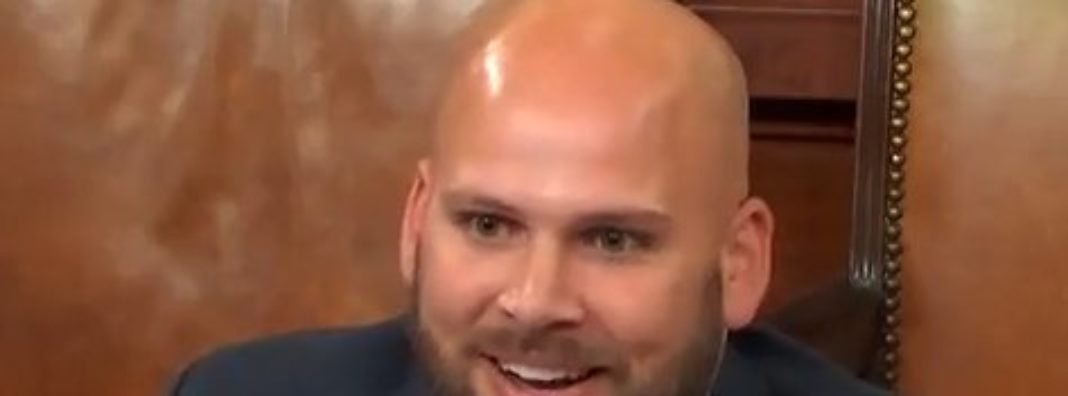
Christopher Koopman, Executive Director at the Center for Growth and Opportunity at Utah State University, testified before the U.S. Congress Joint Economic Committee on May 22, 2018.
The hearing, “Breaking through the Regulatory Barrier: What Red Tape Means for the Innovation Economy,” held in room 1100 of the Longworth House Office Building, focused on the role of regulation in emerging technologies and innovative ideas.
In his written testimony, (full text below) Koopman centered his remarks around the benefits of “permissionless innovation” — when people are allowed to experiment with and act on new ideas without fear of regulatory interference.
“We must reclaim the culture of permissionless innovation that has fueled the growth of the commercial internet and the economic benefits that it has generated,” said Koopman. “Doing so requires a technological freedom not found in many of the current regulatory approaches.”
Creating an Environment for Permissionless Innovation
Testimony before the US Congress Joint Economic Committee
May 22, 2018
Thank you, Chairman Paulsen, Ranking Member Heinrich, and members of the committee, for holding this hearing on this important topic.
My name is Christopher Koopman. I am senior director at the Center for Growth and Opportunity at Utah State University and a senior affiliated scholar at the Mercatus Center at George Mason University. I am grateful for the invitation to discuss opportunities and challenges facing innovators and entrepreneurs in the United States, especially the role regulation is increasingly playing in the innovation economy. This issue parallels much of my work over the past five years, as well as other research projects being pursued at both the Center for Growth and Opportunity and the Mercatus Center. Any opinions I express today are my own and do not necessarily reflect the views of my employer.
The current regulatory environment is inimical to innovation.
- The culture of “permissionless innovation,” which was responsible for much of the economic growth associated with the growth of the internet, is now being stifled by old regulatory regimes.
- Continuing to apply these regimes is not only discouraging innovation, but pushing innovators to pursue better regulatory climates overseas.
- Reforming the regulatory regime is necessary to continue to reap the benefits of innovation we experienced over the past 30 years.
Putting an End to Permissionless Innovation
Over the past 30 years, the growth of the internet as a commercial platform has been marked by a culture of “permissionless innovation.” Vint Cerf, one of the “fathers of the internet,” credits this culture for the economic benefits that the internet has generated.1Vinton G. Cerf, Keep the Internet Open, N.Y. TIMES, May 24, 2012, https://www.nytimes.com/2012/05/25/opinion/keep-the -internet-open.html.As an open platform, the internet has allowed entrepreneurs to try new business models and offer new services without first seeking the approval of regulators. This is no accident. Bipartisan efforts in the 1990s made it the official policy of the United States “to preserve the vibrant and competitive free market that presently exists for the Internet, unfettered by Federal or State regulation.”247 U.S.C. § 230(b)(2) (2016). This guaranteed a platform with little prior restraint on the commercial activities undertaken through the internet. When harms or failures occurred, the country addressed them in an ex post manner.
However, as more industries have been disrupted by technology companies, the culture of permissionless innovation has met a permissioned-based, proscriptive regulatory approach. The costs of these regulatory approaches at both state and federal levels are felt more acutely today by more people because of the simple fact that the internet has made jumping into regulated professions easier than ever before. In a few clicks, one can obtain tax and legal advice,3Search Results for Legal Advice, QUORA, https://www.quora.com/search?q=legal%20advice&type=answer (search “Legal Advice” using the search bar at the top of the page). connect with a doctor thousands of miles away,4See, e.g., TELADOC, https://www.teladoc.com (last visited May 17, 2018). chat with a therapist,5See, e.g., TALKSPACE, https://www.talkspace.com (last visited May 17, 2018). or find a mover.6Help Moving, TASKRABBIT, https://www.taskrabbit.com/m/help-moving-on-demand (last visited May 17, 2018). The natural, geographical barriers to entry that might have kept someone out of these professions in the past have been virtually eliminated, meaning the artificial barriers—particularly licensing and regulatory restrictions—are sometimes all that stand in the way of this activity.
Moreover, as entrepreneurs continue to bring pre-internet practices into the internet age, they are encountering regulatory environments that were never built with smartphones, computers, and the internet in mind. Regulators have viewed these disruptions as per se illegal by the mere fact that decades-old regulations failed to foresee the future we are living in today.
One stark example of this comes in the recent response to flight-sharing platforms. For decades, general aviation pilots and passengers would look at flight plans posted on cork boards at airports to connect with one another in order to share flights. In 2013, a company called Flytenow created an app that consolidated these corkboards into a digital app. This could have revolutionized how we travel. Within two years, the platform hosted 25,000 pilots and passengers to arrange flights nationwide.
However, current FAA guidelines on flight-sharing arrangements never contemplated the information-sharing power of the internet. As a result, the FAA relied on 30-year-old guidance documents to declare pilots using the platform to be “common carriers.” This meant pilots without commercial certification were operating illegally. Private pilots could continue to connect with passengers through physical cork boards, but the Flytenow version—nothing more than a digital cork board on a smartphone—was deemed illegal. This lost opportunity is not a failure of technology but a failure of public policies to accept that the world will continue to change as we find new and better ways of creating value for others through innovation.7Christopher Koopman, Defining Common Carriers: Flight Sharing, the FAA, and the Future of Aviation (Mercatus Center at George Mason University, Working Paper, 2017).
Permissionless Innovation and Global Innovation Arbitrage
Discouraging technological innovation in the United States will not prevent that innovation from happening. This theory is what my colleague Adam Thierer calls “innovation arbitrage.” Simply put, rather than fighting with regulators, innovators will simply go where they are welcome. As Thierer explains,
[I]nnovators can, and will with increasing regularity, move to those jurisdictions that provide a legal and regulatory environment more hospitable to entrepreneurial activity. Just as capital now fluidly moves around the globe seeking out more friendly regulatory treatment, the same is increasingly true for innovations. And this will also play out domestically as innovators seek to play state and local governments off each other in search of some sort of competitive advantage.8Adam Thierer, Innovation Arbitrage, Technological Civil Disobedience & Spontaneous Deregulation, MEDIUM (Dec. 7, 2016), https://medium.com/tech-liberation/innovation-arbitrage-technological-civil-disobedience-spontaneous-deregulationeb90da50f1e2.
While flight-sharing platforms have been grounded in the United States, they have taken off in Europe. Wingly, a European flight-sharing company, recently secured 2 million euros to expand its network across the continent.9Jonathan Keane, Wingly Raises €2 Million for Its Carpooling for Flights Service, TECH.EU, Mar. 5, 2018, https://tech.eu/brief/wingly-funding/. Its online platform enables 150,000 users to hop aboard small private aircraft operated by 10,000 licensed pilots in France, Germany, and the United Kingdom.10Id.
Instead of viewing these platforms as a threat, European Aviation Safety Agency (EASA) administrators have recognized that these platforms were simply extending existing practices by leveraging web-based tools that are already in place. EASA thus expanded its existing regulations to include these internet-based platforms,11Letter from Patrick Ky, Exec. Dir. of EASA, to Emeric Waziers (Mar. 14, 2016), https://fr.wingly.io/media/doc/en/EASA_140316.pdf. and it has actively worked with flight-sharing platforms such as Wingly to promote safety.12WINGLY, SAFETY OF NON-COMMERCIAL GENERAL AVIATION FLIGHTS WITH LIGHT AIRCRAFT (2017). Until the FAA adopts a more accommodating and innovation-friendly disposition, Europe is likely to continue outpacing the United States in this space.
Flight-sharing platforms are but one example. Innovators working on genome editing,13Christopher Koopman and Jordan Reimchisel, Ignoring the Future Won’t Forestall It, U.S. NEWS AND WORLD REPORT, Aug. 21, 2017, https://www.usnews.com/opinion/economic-intelligence/articles/2017-08-21/the-us-ignores-crispr-and-genetic-engineering-issues-to-its-own-detriment. commercial drones,14Jack Nicas and Greg Bensinger, Amazon: U.S. Is Blocking Its Testing of Drones, WALL ST. J., Dec. 8, 2014, https://www.wsj.com/articles/amazon-warns-it-will-move-drone-research-abroad-1418076981. driverless cars,15Chunka Mui, Singapore: The First-Mover Nation for Driverless Cars, STRATEGY+BUSIUNESS, July 26, 2016, https://www.strategy -business.com/blog/Singapore-The-First-Mover-Nation-for-Driverless-Cars.and the sharing economy are all finding more hospitable homes outside the regulatory purview of the United States.
Reclaiming a Culture of Permissionless Innovation
To ensure that the United States remains a leader in the innovation economy, our public policy must have some tolerance for mistakes, failures, and learning so that innovation can continue to move forward. We must reclaim the culture of permissionless innovation that has fueled the growth of the commercial internet and the economic benefits that it has generated. Doing so requires a technological freedom not found in many of the current regulatory approaches.16See, e.g., ADAM THIERER, PERMISSIONLESS INNOVATION: THE CONTINUING CASE FOR COMPREHENSIVE TECHNOLOGICAL FREEDOM (rev. ed., 2016).
In any number of regulatory domains, there are serious and legitimate concerns that make it tempting to require innovators to seek approval before they proceed. While regulatory approval can address many of those concerns, it is done at the expense of continued innovation and economic growth. As my colleague James Broughel explained in his recent book on regulation and economic growth, “Regulations should nurture and not stifle the factors known to be important for growth. These factors include productivity, investment, competition, human capital, institutions, and all the various forms of technological innovation.”17JAMES BROUGHEL, REGULATION AND ECONOMIC GROWTH: APPLYING ECONOMIC THEORY TO PUBLIC POLICY 108–9 (2017).
Conclusion
I thank the committee for its interest in and attention to these issues, as well as for the opportunity to testify.
Sincerely,
Christopher Koopman Senior Director, Center for Growth and Opportunity at Utah State University
Senior Affiliated Scholar, Mercatus Center at George Mason University

